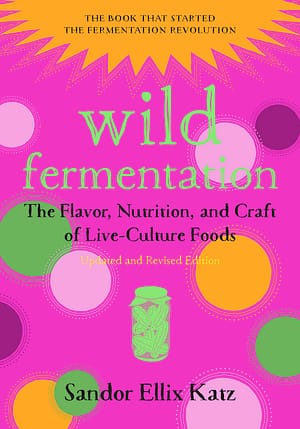Make Your Own Kombucha: The Tea Beast Lives

Kombucha. The tea beast. The new and trendy health drink. The combination black tea and bacteria ball that is known to cure ailments, heal emotional wounds, and impress houseguests who happen upon it by accident when looking for the dog treats. What’s better than drinking this wonderful tea? Making your own.
The following is an excerpt from Wild Fermentation by Sandor Katz. It has been adapted for the web.
Kombucha is a sour tonic beverage, like rejuvelac and kvass, and in Russia, where it has enjoyed long popularity, it is often referred to as “tea kvass.” Kombucha is sweetened black tea, cultured with a “mother,” also known as “the tea beast,” a gelatinous colony of bacteria and yeast. The mother ferments the sweet tea and reproduces itself, like kefir grains.
Kombucha is thought to have originated in China, and has been popular at different times in many different lands. It is beneficial to health, like other live fermented foods, and for a few years in the mid-1990s it was a big American health fad. Any potential cure is appealing to people living with chronic disease. My friend and fellow AIDS survivor Spree got caught up in the kombucha craze. Soon he had more “mother” than he knew what to do with, and started getting everyone to try it. Almost everyone enjoyed the sweet-sour flavor of kombucha. People got really creative with alternative sweet substances for the mother to ferment. I remember our friend Brett Love made kombucha from his favorite soft drink, Mountain Dew. Fermentation processes are very versatile.
The trickiest part of making kombucha is finding a mother. Ask at local health food stores. On the Web, kombucha enthusiasts maintain a Worldwide Kombucha Exchange at www.kombu.de, where mothers are widely available for just shipping costs. Kombucha mothers are also available from G.E.M. Cultures. (See the Cultural Resources section.)
 Timeframe
Timeframe
About 7 to 10 days
Ingredients
For 1 quart/1 liter
1 quart/1 liter water
1⁄4 cup/60 milliliters sugar
1 tablespoon/15 milliliters loose black tea or
2 teabags
1⁄2 cup/125 milliliters mature acidic kombucha
Kombucha mother
Process
- Mix water and sugar and bring to a boil in a small cooking pot.
- Turn off the heat; add tea, cover, and steep about 15 minutes.
- Strain the tea into a glass container. It’s best to use something wide; kombucha needs adequate surface area and works best if the diameter of the container is greater than the depth of the liquid.
- Allow the tea to cool to body temperature.
- Add the mature acidic kombucha. When you obtain a culture, it will be stored in this liquid. Save a portion of subsequent batches for this purpose.
- Place the kombucha mother in the liquid, with the firm, opaque side up.
- Cover with a cloth and store in a warm spot, ideally 70° to 85°F (21° to 29°C).
- After a few days to 1 week, depending on temperature, you will notice a skin forming on the surface of the kombucha. Taste the liquid. It will probably still be sweet. The longer it sits, the more acidic it will become.
- Once it reaches the acidity you like, start a new batch and store your mature kombucha in the refrigerator. You now have two mothers, the original one you started with, and a new one, the skin that formed on your first batch. Use either the new or the old mother in your new batch, and pass the other one on to a friend (or the compost). Each generation will give birth to a new mother, and the old mother will thicken.
Recommended Reads
Recent Articles
What’s so great about oyster mushrooms? First, you can add them to the list of foods that can be grown indoors! They are tasty, easy to grow, multiply fast, and they love a variety of substrates, making oyster mushrooms the premium choice. The following is an excerpt from Fresh Food from Small Spaces by R. J.…
Read MoreCraving something sweet? These delicious maple roasted nuts are the perfect treat to help you push through those end-of-winter blues. The following is an excerpt from Full Moon Feast by Jessica Prentice. It has been adapted for the web. The Magic of Maple: A Rich History Following the Hunger Moon, just before the first thaw…
Read MoreDoes the cold weather have you dreaming about fresh greens and colorful salad? Grow and harvest sprouts indoors to make those dreams a reality! Follow this quick start guide to year-round greens for fresh salad greens in just a couple of weeks! The following is an excerpt from Year-Round Indoor Salad Gardening by Peter Burke. It…
Read More









